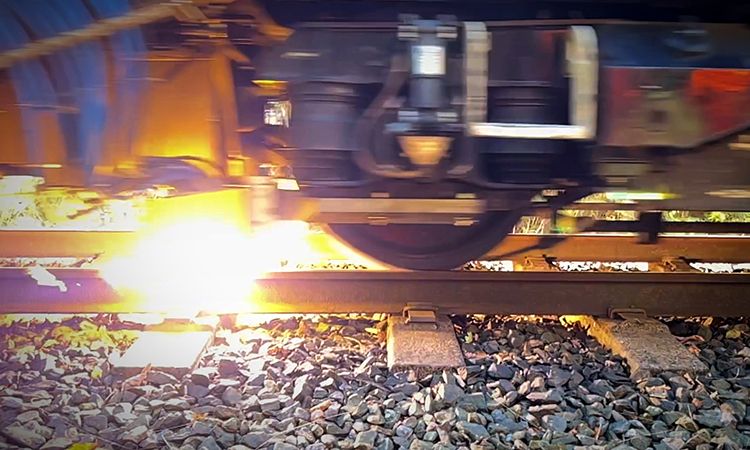Laser and plasma train trials clear autumn leaves off UK lines
Posted: 26 October 2022 | Elliot Robinson (Editorial Assistant - Global Railway Review) | No comments yet
Network Rail have been trialling space-age laser and plasma jet technology as a way to clear autumn leaves from railway lines and minimise passenger delays.


Credit: Network Rail
Network Rail has been carrying out comprehensive testing throughout October, using its multi-purpose vehicles (MPVs) on heritage lines at the East Lancashire Railway.
The testing
Engineers have been testing if autumn treatment trains fitted with the laser beams and superheated plasma jets are as effective at cleaning rails as the current method using high pressure water systems. During autumn, train wheels compress leaves onto rails and form a black Teflon-like residue which makes it harder for trains to brake or accelerate.


Credit: Network Rail
“Leaves on the line are often seen as a joke on the railway but they can cause serious problems and we’re always looking at new ways to tackle this age-old problem,” Suhayb Manzoor, Project Engineer for Network Rail, said. “It’s also not unique to Britain, with railways all over the world having issues when trees shed their leaves. For that reason, it’s exciting to be putting some of the newest technology out there to the test with the hope that one day it could help Network Rail keep passengers and freight moving safely at this operationally challenging time of year.”
The two different companies involved in the testing are:
- Laser Precision Solutions – The ‘LaserTrain’ uses three high powered beams per railhead to treat the rails. When the intensity of the lasers hits the railhead the contamination instantly vaporises (ablates), without heating up the rail.
- PlasmaTrack – Uses direct current (DC) plasma technology which uses heat and active electrons to split things apart. The high energy electrical plasma beam tears apart the leaf layer as well as heating and burning it off.
Current treatment
Currently a fleet of leaf-blasting trains with high-pressure water jets clear Britain’s 20,000-mile railway network in the autumn.
Each year:
- The treatment fleet covers 1 million miles between October and December
- That’s the entire network being treated 50 times over
- Or the same as going to the moon and back twice
- It uses around 200 million litres of water
This technology could potentially reduce the need for that water, and the fuel needed to transport it around the country, benefiting both the environment and costing the taxpayer less. If the tests find lasers or plasma can clean the rails effectively, further development work will be needed to see if it would work on the complexities of the live railway network. Further studies would also be required to examine the business case for adopting any new technology.
Related news you will enjoy:
Network Rail continues £15.5m improvement work at Clapham Junction
Network Rail signs solar power agreement for a greener railway


Credit: Network Rail
“Normally you really have to move mountains to get access to a railway network, so having a testing site like this which is secluded where you can take measurements every day is essential to gather data,” Ben Medendorp, Head of Finance and Commerce for Laser Precision Solutions, said. “I really do think that Network Rail is taking a leadership role in the industry by solving this global issue of low railhead adhesion. We are proving technologies and learning valuable lessons that could help railways around the world.”
“Having three weeks of uninterrupted testing available on an operational railway isn’t usually possible so being able to carry out these trials with Network Rail and East Lancashire Railway have been invaluable,” Julian Swan, Chief Executive Officer for PlasmaTrack, said. “We’ve learnt a lot on how the autumn treatment trains (MPVs) currently operate, and how the PlasmaTrack system could benefit train wheel traction and protecting wheel-slide caused by leaves on the line.”
“When people think of heritage railways, they probably think they just look at preserving the past, but here at the East Lancashire Railway we want to be a moderniser too,” Mike Kelly, Chairman for East Lancashire Railway, said. “We’re very proud to be able to play our part and provide our tracks and infrastructure to allow Network Rail to do their important research and development, and excited to be at the forefront of technology which could make millions of future journeys better for passengers across the country.”
Stay Connected with Global Railway Review — Subscribe for Free!
Get exclusive access to the latest rail industry insights from Global Railway Review — all tailored to your interests.
✅ Expert-Led Webinars – Gain insights from global industry leaders
✅ Weekly News & Reports – Rail project updates, thought leadership, and exclusive interviews
✅ Partner Innovations – Discover cutting-edge rail technologies
✅ Print/Digital Magazine – Enjoy two in-depth issues per year, packed with expert content
Choose the updates that matter most to you. Sign up now to stay informed, inspired, and connected — all for free!
Thank you for being part of our community. Let’s keep shaping the future of rail together!
Related topics
Bogies & Wheelsets, Infrastructure Developments, Passenger Experience/Satisfaction, Safety, Sustainability/Decarbonisation, Technology & Software, Track/Infrastructure Maintenance & Engineering
Related organisations
East Lancashire Railway, Laser Precision Solutions, Network Rail, PlasmaTrack







